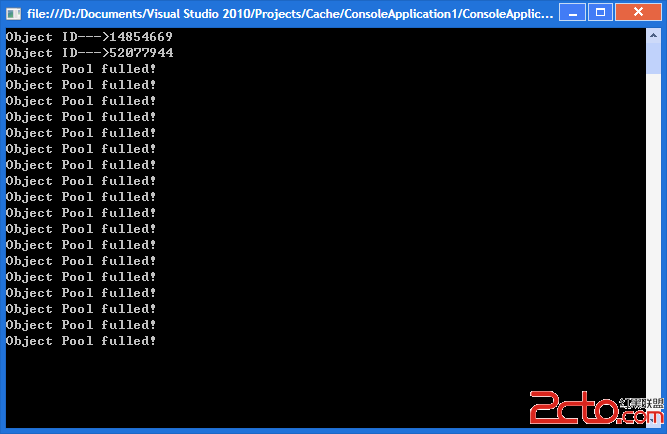對象池服務可以減少從頭創建每個對象的系統開銷。在激活對象時,它從池中提取。在停用對象時,它放回池中,等待下一個請求。
我們來看下主線程中,如何與對象池打交道:
static void Main(string[] args)
{
InstancePoolResolver.Register<OrderQueryServiceInterface, OrderQueryService>();
while (true)
{
Thread.Sleep(2000);
Console.Clear();
for (int i = 0; i < 20;i++ )
{
ThreadPool.QueueUserWorkItem(new WaitCallback(ConsumeObject));
}
}
}
private static void ConsumeObject(object state)
{
OrderQueryServiceInterface srv = null;
try
{
using (srv = InstancePoolResolver.Resolve<OrderQueryServiceInterface>()) //從對象池中取得對象,沒有可用對象則throw exception
{
Console.WriteLine("Object ID--->" + srv.GetHashCode());
Thread.Sleep(1000); //故意長時間占用對象
}
}
catch (Exception ex)
{
Console.WriteLine(ex.Message);
}
finally
{
if (srv != null)
srv.Dispose();
}
} 運行效果:

最多只有2個instance,那在哪裡設置這個數量呢?請看
是通過Attribute打tag上去的
下面來看看最核心的InstancePoolResolver類
public sealed class InstancePoolResolver
{
private static Dictionary<Type, Type> typeMappers = new Dictionary<Type, Type>();
private static Dictionary<Type, int> typeMappersMaxInstanceCount = new Dictionary<Type, int>();
private static Dictionary<Type, List<PoolableObject>> typeInstances = new Dictionary<Type, List<PoolableObject>>();
private static object o4lock = new object();
public static void Register<T, TProvider>()
where TProvider : class, new()
{
if (typeMappers.ContainsKey(typeof(T)))
throw new Exception("Key existed");
lock (o4lock)
{
Type t = typeof(T);
typeMappers.Add(t, typeof(TProvider));
typeInstances.Add(t, new List<PoolableObject>());
InstanceSettingAttribute setting = GetInstanceSettingAttribute(typeof(TProvider));
typeMappersMaxInstanceCount.Add(t, setting.MaxInstanceGlobal);
}
}
public static T Resolve<T>()
where T: PoolableObject
{
Type t = typeof(T);
if (!typeMappers.ContainsKey(t) || !typeInstances.ContainsKey(t))
throw new Exception("Key empty, register please");
lock (o4lock)
{
List<PoolableObject> instances = typeInstances[t];
if (instances == null)
{
instances = new List<PoolableObject>();
typeInstances[t] = instances;
}
foreach (PoolableObject o in instances)//是否已經存在已有閒置對象
{
if (o.IsInPool)
{
o.IsInPool = false;
return (T)o;
}
}
if (instances.Count < typeMappersMaxInstanceCount[t])//new新對象到對象池中
{
Type type = typeMappers[t];
PoolableObject obj = (PoolableObject)Activator.CreateInstance(type);
instances.Add(obj);
obj.IsInPool = false;
return (T)obj;
}
}
throw new Exception("Object Pool fulled!"); //沒有多余的資源
}
private static InstanceSettingAttribute GetInstanceSettingAttribute(Type type)
{
object[] attrs = type.GetCustomAttributes(typeof(InstanceSettingAttribute), false);
if (attrs == null || attrs.Count() == 0)
return new InstanceSettingAttribute() { MaxInstanceGlobal=10};
return (InstanceSettingAttribute)attrs[0];
}
}